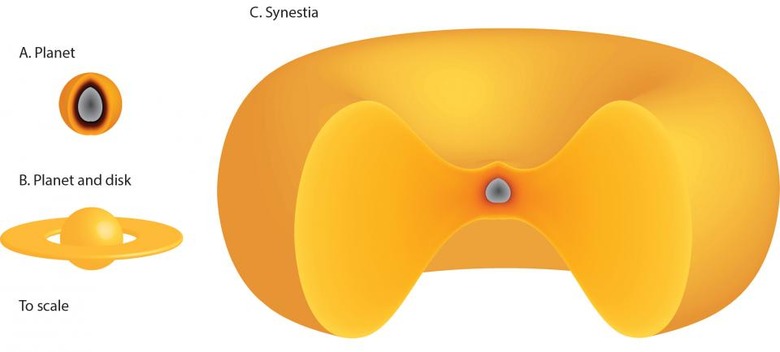One Lit Moon Donut: A New Creation Model For Our Closest Space Neighbor
Researchers report they have a new theory for how our moon formed in the aftermath of our Earth's most major collision. The moon and the Earth – or what started as two planetary bodies – likely collided and formed a donut-shaped type of planetary object called a "synestia." "We looked at the statistics of giant impacts, and we found that they can form a completely new structure," said researcher Sarah Stewart. In May of 2017, the first report of synestia came from some of the same researchers working on the report we're exploring today: Sarah Stewart and Simon Lock.
According to these two reports, synestias likely form when two planet-sized objects collide in space with proper energy and angular momentum. The image you see below depicts a planet, a planet and disk, and a synestia, all to scale in relation to one another. Tis illustration was made by Lock for the first of two reports.

"In a typical super-CoRoL (corotation limit) body, traditional definitions of mantle, atmosphere and disk are not appropriate, and the body forms a new type of planetary structure, named a synestia," said Lock in the group's lunar paper abstract. "Using simulations of cooling synestias combined with dynamic, thermodynamic and geochemical calculations, we show that satellite formation from a synestia can produce the main features of our Moon."
The previous most accepted model for the formation of the moon did not account for the lack of volatile elements on the moon. The moon should have the same set of volatile elements as our Earth if indeed the Earth and Moon were created from the same cloud of vaporized rock. Until now, there was no solid idea why the moon lacks said elements.
Now, according to this new model, the moon would very easily have formed in a different way from the Earth, allowing it to exist without the exact same set of elements. In this model, our moon formed in a haze of atmospheres of vapor. This vapor was hot – up to 4000-6000 degrees fahrenheit (approximately 2200-3300 degrees celsius.)
The paper on synestias – the first of two papers – was published in Wiley (AGU Publications) for the Journal of Geophysical Research: Planets. The paper went by the title "The structure of terrestrial bodies: Impact heating, corotation limits, and synestias." This paper works with code DOI: 10.1002/2016JE005239 and was authored by Simon J Lock and Sarah T Stewart.
The paper on our moon more specifically can be found also in the Journal of Geophysical Research: Planets hosted by Wiley (AGU Publications). This second paper goes by the title "The origin of the Moon within a terrestrial synestia" and can be found with code DOI: 10.1002/2017JE005333. This paper was authored by Simon J. Lock, Sarah T. Stewart, Michail I. Petaev, Zoë M. Leinhardt, Mia T. Mace, Stein B. Jacobsen, and Matija Ćuk.
